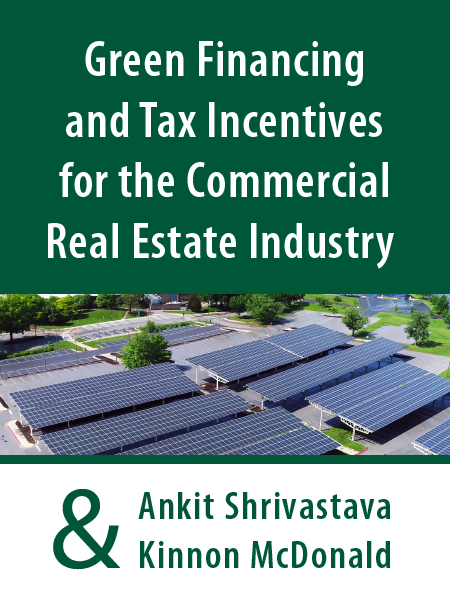
The application of ESG considerations varies from industry to industry; however, the impacts of climate change particularly affect the real estate industry. The increased frequency and strength of natural disasters not only affects the physical safety of properties but also threatens investments. Investors are beginning to recognize the impacts of climate change and are incorporating these externalities into their investment strategies. Several green financing options have gained popularity to offset the significant upfront capital investment required to construct, renovate, or retrofit buildings to reach sustainability goals. Similarly, tax incentives have been recently expanded to promote energy-efficient improvements. This article will discuss some of these green financing options and tax incentives.
C-PACE
Commercial Property Assessed Clean Energy (C-PACE) financing assists property owners in covering the upfront costs of eligible energy efficiency improvements and ground up construction projects. C-PACE financing requires state and local authorization. A private lender then provides financing to a local authority that will oversee the C-PACE programs. The financing allocated to a project is recorded in the land records and runs with the land until the assessment is paid off, which is on a five to- 30-year term. The local tax authority includes the C-PACE special assessment as a line item on the property’s tax bill, which is collected to reimburse the private lender. Although this is the usual C-PACE structure, C-PACE legislation is not universal across the country. State and local authorities apply different rules and regulations, so it is important to understand how the local C-PACE financing structure will affect a project.
Typically, 20 to 25 percent of development costs are eligible for C-PACE financing, and the financing is usually less than three to five percent of the collateral value. C-PACE financing is offered at a fixed rate, which is normally around five to six percent, and does not include a balloon payment. It is nonrecourse because it is tied to the property instead of the owner and is usually automatically transferable upon the sale of the property. The consequences of defaulting under C-PACE financing are similar to failing to pay a property tax bill.
C-PACE programs are gaining in popularity, with 39 states and the District of Columbia approving programs. More than $4 billion has been allocated to projects since 2009. C-PACE programs are popular because they provide for longer-term amortization without upfront investment. However, there are some considerations to account for in deploying C-PACE financing. For example, lenders and mortgage-holders may take issue with the funding structure because the debt is tied to the property and thus their interests may be subordinated to C-PACE financing.
Even with these considerations, lenders may consent to C-PACE financing because it cannot be accelerated, nor does it affect a lender’s existing foreclosure rights and remedies since the C-PACE structure and financing does not require inter-creditor agreements. Even though inter-creditor agreements are not required, lenders often request a recognition agreement, as well as control over the disbursement of funds and a waiver of prepayment penalties in case of foreclosure. Recourse or construction guaranties, which are terminated upon completion, are becoming more common with C-PACE financing. Lenders can also require the property owner to escrow C-PACE assessments, like other property taxes.
C-PACE is a cost-effective financing option because interest rates are typically lower than other financing or forms of debt (such as mezzanine debt) that are not secured by the property so it can help improve debt service coverage. Ultimately, C-PACE programs can benefit the asset by modernizing the property, which reduces operating costs and increases net operating income (NOI) and valuation of the property. C-PACE financing is relatively new and lenders may require negotiated changes to get comfortable with the financing structure, so it is important to include counsel early in the process.
Energy-as-a-Service
In another attempt to create efficient and flexible energy platforms without large upfront capital expenditures from customers, energy providers are implementing a new business strategy known as Energy-as-a-Service (EaaS). The EaaS business model replaces the old subscription model where a service provider charges a customer for energy consumed by hardware, software, and other monitoring services.
In the EaaS model, the subscribers are private sector commercial building owners. An energy company evaluates the building and makes energy efficient upgrades, which can include: (i) retrofitting lights and HVAC systems; (ii) implementing renewable sources like solar and wind; and (iii) incorporating on-site energy storage systems, smart thermostats, and electronic vehicle chargers. Energy providers also offer additional services like energy management to track energy consumption and adopt strategies to meet energy efficiency goals.
The energy provider retains ownership and manages the equipment for the term of the subscription, which is typically five to 20 years. The subscriber pays a recurring subscription fee for the services that is ultimately less than the original utility bill. At the end of the term, the subscriber can either extend the term, purchase the equipment, or return the equipment to the energy company. EaaS is a popular financing structure because the building owner benefits from the expertise of the energy provider managing and operating the equipment. Because the energy provider retains ownership of the equipment, the financing is off-balance-sheet financing.
CLICK HERE to read the full article, which was originally published in ALI CLE’s The Practical Real Estate Lawyer.

The Practical Real Estate Lawyer
Subscribe to the print or digital version of The Practical Real Estate Lawyer today.
